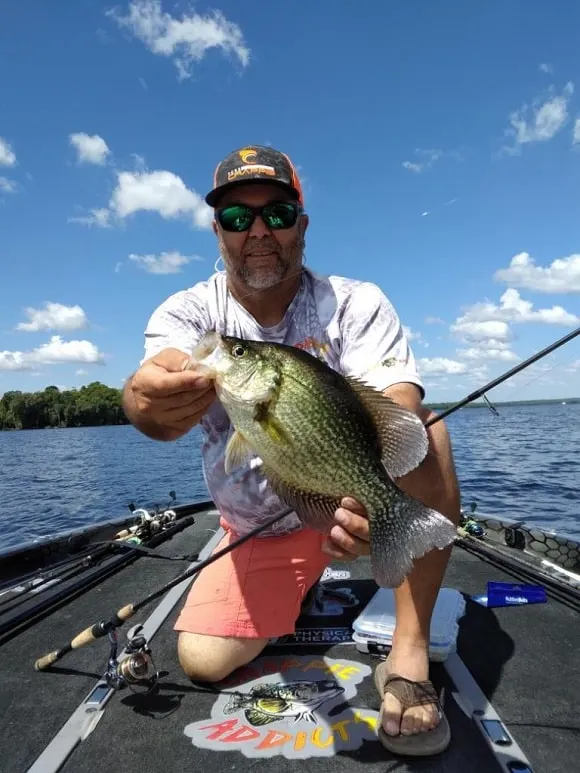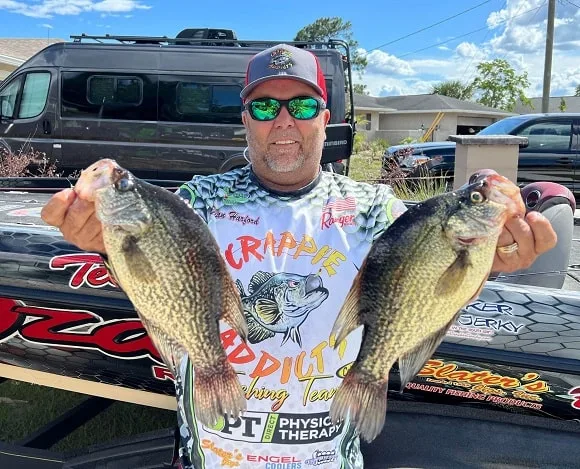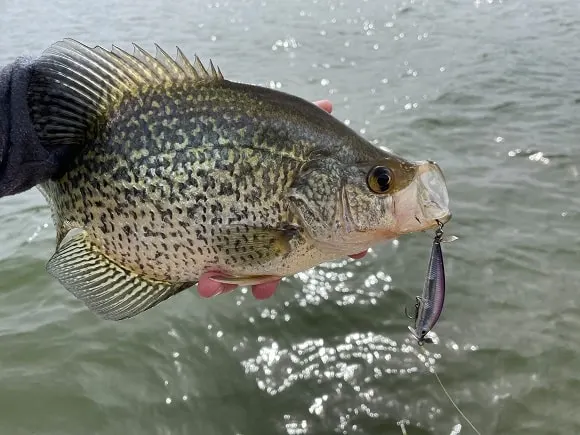There are so many crappie lines out there, and for many anglers, choosing the right type of line and pound test can be difficult.
To help you make the most informed decision, I wrote this helpful article on the best and most appropriate fishing lines for crappie.
While a braided mainline is the perfect pick when fishing near heavy cover, you should use a monofilament line when fishing with live baits on the slip bobber. Fluorocarbon is a great choice when fishing in clear water with high visibility.
Continue reading this article and find out exactly when and why you should use braid, mono, or fluorocarbon for your crappie fishing.
QUICK SUMMARY: This article includes recommendations for the best crappie fishing lines. If you’re in a hurry to get fishing, you can check them out on Amazon right now! They are the Power Pro Spectra Braid, KastKing World’s Premium Monofilament, and Berkley Trilene 100% Fluorocarbon.
What Type of Line Is Best for Crappie?
You can use both braid, monofilament, and fluorocarbon mainlines when fishing for crappie. Your fishing method, water clarity, and the type of spot you’re targeting will determine what line material to use.
Because while you can certainly use one type of mainline for all your fishing, adapting your tackle to the various factors and conditions at hand can make all the difference.
Is the water stained or crystal clear? Is there a lot of cover? Are there many features and snags around, or do you fish in completely open water? And how deep or shallow are you fishing?
Additionally, your fishing technique should dictate which type of mainline you should use.
Are you jigging or casting small crankbaits? Or are you fishing a slip bobber rig?
Not all lines work equally well for all those situations and techniques, you see!
So when should you use braid, mono, or fluorocarbon when fishing for crappie? Let’s take a closer look!
When Should You Use Braid?

A braided mainline is an excellent option for many crappie fishing situations.
Braid is best used when fishing with lures in both open deeper water and shallow areas with heavy cover. It’s also a perfect option when fishing in stained and muddy water.
This type of mainline has a phenomenal strength-to-diameter ratio, allowing you to fish with a very strong yet very thin line, which is great for snaggy areas.
PRO TIP: Thanks to its strength, braid is also a solid choice for shore anglers. It can save you plenty of lures that might get snagged when fishing from the bank.
Additionally, it has very low memory and basically no stretch to it, which is a huge advantage when fishing with smaller lures.
You’ll get great lure control and feel every little tug by the fish, helping you to react fast and hook more crappie.
There are a few cons with a braid mainline, though! One is that braid is pretty expensive, which means that it might not fit everyone’s budget.
Another con is that lower-diameter braid lines often have lower abrasion resistance, so make sure you don’t use it close to sharp snags like mussel banks or rocks.
Braid also has high underwater visibility, especially if you’re using a dark-colored line. That’s why I wouldn’t use it in very clear water conditions!
PRO TIP: If you’re fishing in clear water and still want to use braid, you can always connect a long fluorocarbon leader to your braided mainline! Just make it at least 6 feet long! It’s not perfect, but it’s better than nothing.
When Should You Use Mono?

Monofilament is probably still the most widely used type of mainline for crappie fishing. It’s a very versatile mainline that works great in many situations.
Mono mainlines are best used when crappie fishing with live baits on the slip bobber rig. They can also be used when lure fishing or jigging at close range in shallower water.
Even though braid is probably the better choice for lures, some people do prefer monofilament. And why not; it’s a reliable and easy-to-handle type of line that gets the job done.
Sure, you won’t get as much feel out of it as with braid, but sometimes, that’s actually not that important!
However, mono works best when fishing with a bobber and live bait. As it has a lot of memory and stretch, it acts as a buffer when striking, often resulting in a better hook set and more landed fish.
Additionally, mono line floats, making it a great choice when fishing with a slip bobber rig. It’s a definite advantage when you get that 90-degree angle into your line, as it’ll give you a much better rig presentation beneath your bobber!
On the other hand, its floating ability is a clear disadvantage when luring fishing in deeper water, as you’ll want to present your rig and lure as suspended as possible!
That’s why mono generally only works when lure fishing at close range and in shallow water.
PRO TIP: As monofilament is very cheap and easy to fish with, it’s probably your best pick if you’re a beginner! Start with mono, improve your fishing skills, then upgrade to braid or fluorocarbon if and when needed!
When Should You Use Fluorocarbon?

In recent years, using fluorocarbon as mainline has become ever more popular. And while it’s not for everyone, it can certainly be advantageous for your crappie fishing!
This type of line is a superior choice when fishing in clear water with very high visibility. You can also use it when fishing for suspended crappie in greater depths.
Fluorocarbon line is virtually invisible underwater, giving you a huge advantage when fishing in high visibility conditions.
As they can see everything in the clear water, the fish can be extremely finicky and hard to catch, so you’ll want to fish as stealthily as possible.
While a longer fluorocarbon leader on mon or braid can sometimes do the trick, very often, it’s much better to go invisible all the way, and that’s best done with an FC mainline!
You can fish your fluorocarbon line straight down to your hook; no extra knots and total invisibility all the way!
Fluorocarbon line also sinks, which is excellent when fishing further down in the water column.
To reach those suspended crappies in open water, you will want your jigs or cranks to sink fast to present them at the proper depth. And that’s very easily accomplished with a sinking FC mainline, even at close range!
Of course, the fluorocarbon’s sinking ability doesn’t make it a great choice for bobber fishing.
Additionally, you don’t have to use an FC mainline in stained water conditions. It’s simply not needed!
Fluorocarbon can be quite costly, so check your target water and see if you really need it!
Best Braided Line for Crappie Fishing
The Power Pro Spectra is one of America’s most popular braids. I’ve used this line for many years and couldn’t be happier!
It’s a super strong braided line with exceptional strength, smoothness, and durability.
It’s also extremely thin, so you’ll barely see it underwater if you use an appropriate pound test. And that’s really something when it comes to braid.
I also really like the moss-green color of this line. In dark or muddy water, it blends right in and becomes practically invisible.
You’ll get a lot of line for your money, and the Power Pro is the perfect choice when jigging, flipping, or fishing with smaller crankbaits near or in heavy cover!
You can check out the Power Pro Spectra on Amazon right here
What Pound Test Braid Is Best for Crappie?
When fishing in open water without the risk of getting snagged, you can use a 10-12lb test for crappie. In areas with heavy cover and lots of snags, you should up that to at least 15 pounds.
Although, as the Power Pro is so thin, you can easily go up to 20 lb if you want to play it completely safe.
The fish won’t mind, and you’re almost guaranteed to get all your snagged lures back!
Best Monofilament Line for Crappie Fishing
KastKing has become a go-to brand for many anglers, and their World’s Premium Monofilament is a super popular line choice among crappie anglers.
This mono line is extremely clear, making it almost as invisible as fluorocarbon!
Furthermore, it has superior abrasion resistance. You can safely cast your slip bobber rig right into the thickest cover with no worries whatsoever!
Its greatest strength is its price, as you can get 300 years for a very reasonable price.
Thanks to its outstanding quality, this makes it a brilliant choice for both beginners and seasoned anglers, as well as youngsters and anglers with a limited budget.
Take a closer look at the KastKing World’s Premium Monofilament on Amazon here
What Pound Test Monofilament Is Best for Crappie?
In most cases, a 6 lb test mono line will be perfect for crappie. You can go as low as 4 lb in open water and as high as 8 lb when fishing near heavy cover if you want to.
I would, however, avoid a 4-pound test, as it’s on the border of being too light! The KastKing is a very clear and invisible line, so you really don’t have to go that low!
An 8-pound test, on the other hand, is totally okay to put on. For the same reason! The fish won’t be able to spot it, and you can fish confidently and safely.
So if and when you hook up to that giant trophy slap, you don’t have to fear that it’ll break you off!
Best Fluorocarbon Line for Crappie Fishing
When it comes to fluorocarbon mainlines and leaders alike, Berkley is an excellent choice!
They make super-qualitative lines, and millions of anglers use their products with great success.
Berkley’s 100% Fluorocarbon is an outstanding FC mainline perfect for lure fishing for suspended crappie.
It’s incredibly durable and sensitive and has unbelievable abrasion resistance and knot strength, given the thin diameter you use for this type of fishing.
As FC is a little stiffer than mono, it maintains direct contact with your lure at all times, resulting in great sensitivity and feel.
Braid will have the same effect, but if you’re fishing in open, clear water, the fluorocarbon’s invisibility definitely wins over the braided line!
Just remember; fluorocarbon can be a little tricky and takes some getting used to, so it’s not for everyone. Especially beginners can sometimes have a hard time handling an FC mainline.
However, if you know how to handle your line and end tackle, using fluorocarbon when jigging for suspended crappie can be a real game changer!
Check out Berkley’s impressive 100% Fluorocarbon line on Amazon here
What Pound Test Fluorocarbon Is Best for Crappie?
Much like monofilament, a 4 to 8-pound test is generally recommended for crappie fishing, with a 6-pound test being the most appropriate choice for most anglers.
Again, though, I usually don’t advise anglers to use a 4lb mainline. If you get snagged or hook up to a massive and wild fish, there’s a considerable risk that a 4-pound test won’t be up for the job!
Play it nice and safe with a 6-pound mainline. That’s my advice!
And if you’re fishing close to some really nasty snags, up that to an 8 or even a 10-pound test! Remember, FC has extremely low visibility; the fish won’t mind a bit!
Are Crappie Line Shy?
That’s the main question! Do crappies actually get spooked by your fishing line? If you’re fishing in clear water conditions with high visibility, the answer is undoubtedly yes!
Crappie are primarily sight feeders, meaning they can see everything well and clearly. That includes your fishing line.
Especially in clear water that gets hit by plenty of sunlight, the fish van get very easily spooked by a visible line underwater. Ask any serious crappie angler out there, and they’ll tell you the same thing!
That’s why it’s so essential to have this discussion about the different types of mainline.
It might sound a little overkill, but if adapting your tackle to the conditions at hand can result in catching more and bigger fish, it’s well worth the consideration.
Should You Use a Leader for Crappie Fishing?
The last question for this article is if and when you should use a leader for crappie. Does it make sense in certain situations and when using certain tackle?
Once again, the answer is yes; you should definitely be using a fluorocarbon leader if you’re fishing in clear water, sunny weather, and with braid!
Now obviously, you won’t need an FC leader if you’re already fishing with a fluorocarbon mainline! It’s equally unnecessary to put on a fluorocarbon leader if you’re using low-visibility (read clear) monofilament.
But for those dark-colored mono lines and braid, an FC leader is always the right option, especially when fishing in water with high visibility.
Remember, those big crappie eyes can see a lot, and if they make out your mainline, it can most certainly turn them off and spook them!
Essential Gear Tips
If you’re looking for solid and reliable crappie fishing gear, these tips might be useful for you.
This gear and tackle is of top quality and sells at a very decent price on Amazon:
Fenwick Eagle 7′ Light Crappie Spinning Rod
A solid and popular all-around spinning rod! This Fenwick rod is lightweight, has great sensitivity, and phenomenal action. Fits both beginners and seasoned anglers. A 6’6” or 7′ light rod is your best pick for crappies.
Pflueger President 10 Spinning Reel
An affordable high-performance spinning reel that’s perfect for crappie. Pflueger spells high quality and awesome durability! Makes for a great combo together with the Fenwick spinning rod. A size 10 is a solid choice for crappie!
One of the best braids available today! Zero stretch, great feel, and immense strength make this line the perfect pick for crappie! Use a 6-8lb test in open water and a 10-15lb test when fishing near or in heavy cover.
Related Articles
Featured image courtesy of Dan Spengler




